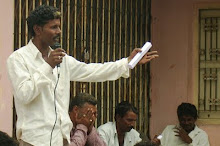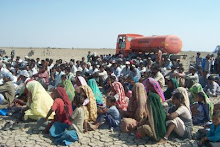Hindustan Times: Ahmadabad: Friday, 2nd August 2024.
The survey recognised only those Agariyas who were lease holders in 1976 when the sanctuary was declared. At that time, there were less than 500
Thousands of traditional salt workers Agariyas are at risk of facing eviction due to a survey and settlement report that recognises the rights of only 497 individuals in the Wild Ass Sanctuary located in the Little Rann of Kutch in Gujarat.
Gujarat produces more than 70% of the country’s salt production, with about 30% originating from the Little Rann of Kutch. Annually, from September to October, traditional salt workers from over 107 villages in Surendranagar, Morbi, Patan, and Kutch districts migrate to the Little Rann to produce salt, sustaining their families through this labour-intensive process.
The Little Rann of Kutch was declared a sanctuary in 1973, and the survey and settlement processes began in 1997. Recent restrictions on salt production have left Agariya families fearing for their future.
Pankti Jog, an RTI activist working with Agariyas for nearly two decades, sought the Survey and Settlement Report for the Wild Ass Sanctuary through an RTI request.
According to Jog, the report, prepared from 1997 to 2018, has been used to limit their access to the sanctuary for salt-making purposes.
However, according to officials aware of the report, it was not the final report. Jog argued before the RTI Commission that actions were already being taken based on the current report. “After which they recently shared it with me,” Jog said.
The Littel Ran of Kutch remained unsurveyed since independence and hence was allotted single survey number ‘Zero’. The total area of the Wild Ass Sanctuary according to the notifications of 1973 and 1978 is 4952.81 sq km or 4,95,281 hectares.
AM Soundarva, senior surveyor of the Wild Ass Sanctuary, provided insight into the current situation. He confirmed that their report has been submitted to the government, who will make the final decision.
Regarding the Agariyas’ rights, Soundarva said, “The survey recognised only those Agariyas who were lease holders in 1976 when the sanctuary was declared. At that time, there were less than 500. Today, their families, extended families, and relatives are also engaged in salt production in the sanctuary, but their lease rights cannot be recognised.”
Soundarva said that the government has in the past attempted to address this issue. “In 2016, the government gave them an opportunity to come forward and claim their rights. Only those with documentary evidence were considered.”
The population of Wild Ass was around 700 when the sanctuary was declared, and they have steadily risen to over 6,000 today.
The Little Ran of Kutch has dual characteristics that of a wetland and a desert. From June to September, the entire desert gets submerged in rainwater as well as seawater, halting all salt-making activities here. Fishing activity is carried out during these four months.
Harinesh Pandya, managing trustee of Agariya Heet-Rakshak Samiti, an NGO working in the Little Ran of Kutch having about 6,000 Agariyas as its members, decried the report as unjust, saying that “no survey of the Little Rann was ever conducted before or after independence. The land records do not reflect the Agariyas’ traditional rights.”
Pandya noted that some pre-independence claims have been recognised while post-independence leases are deemed invalid. Traditional Agariyas, who have harvested salt for generations, do not require leases under the 1948 ‘Salt Expert Committee’ decision, according to Pandya.
He said that the Gujarat government, in its affidavit to the high court, has in the past acknowledged the presence of 59,600 Agariyas in the Rann. Additionally, the Rural Labor Commissioner’s office has documented 7,600 Agariya families engaged in salt production, he added.
Government agencies provide various services to these families during the salt season, including water, education, health, safety kits, and nutrition. Approximately 4,800 families have received solar water pump systems at subsidised rates, Pandya said.
“Despite occupying only 6% of the sanctuary’s 495,000 hectares, Agariyas seek only seasonal usage rights, not ownership, ensuring the land remains under the sanctuary’s jurisdiction,” said Jog.
However, in recent years, the Forest Department has restricted their access, citing their absence from the survey report, according to Jog.
“Last season, stringent security measures were enforced to prevent Agariyas from entering the Rann, prompting widespread protests and eventual intervention by public representatives,” she added.
Pandya called for a reevaluation of the survey and settlement report, urging the government to consider the traditional rights of the Agariyas. “Generations of Agariyas have been producing salt without any formal documentation. The government’s demand for such documents is both impractical and unjust,” he said.
The Agariya Heet Rakshak Manch has proposed that local panchayats and gram sabhas verify and acknowledge the rights of traditional Agariyas, ensuring that their claims are validated based on community knowledge and historical presence rather than formal land records. This approach, they argue, would provide a fair and just resolution, allowing Agariyas to continue their traditional occupation without the fear of losing their means of survival.
Last year, in a boost for the Agariyas, the state government had come out with a notification that allowed salt pan workers holding leases up to 10 acres to continue their age-old tradition of salt production in the Little Rann of Kutch.
The survey recognised only those Agariyas who were lease holders in 1976 when the sanctuary was declared. At that time, there were less than 500
Thousands of traditional salt workers Agariyas are at risk of facing eviction due to a survey and settlement report that recognises the rights of only 497 individuals in the Wild Ass Sanctuary located in the Little Rann of Kutch in Gujarat.
Gujarat produces more than 70% of the country’s salt production, with about 30% originating from the Little Rann of Kutch. Annually, from September to October, traditional salt workers from over 107 villages in Surendranagar, Morbi, Patan, and Kutch districts migrate to the Little Rann to produce salt, sustaining their families through this labour-intensive process.
The Little Rann of Kutch was declared a sanctuary in 1973, and the survey and settlement processes began in 1997. Recent restrictions on salt production have left Agariya families fearing for their future.
Pankti Jog, an RTI activist working with Agariyas for nearly two decades, sought the Survey and Settlement Report for the Wild Ass Sanctuary through an RTI request.
According to Jog, the report, prepared from 1997 to 2018, has been used to limit their access to the sanctuary for salt-making purposes.
However, according to officials aware of the report, it was not the final report. Jog argued before the RTI Commission that actions were already being taken based on the current report. “After which they recently shared it with me,” Jog said.
The Littel Ran of Kutch remained unsurveyed since independence and hence was allotted single survey number ‘Zero’. The total area of the Wild Ass Sanctuary according to the notifications of 1973 and 1978 is 4952.81 sq km or 4,95,281 hectares.
AM Soundarva, senior surveyor of the Wild Ass Sanctuary, provided insight into the current situation. He confirmed that their report has been submitted to the government, who will make the final decision.
Regarding the Agariyas’ rights, Soundarva said, “The survey recognised only those Agariyas who were lease holders in 1976 when the sanctuary was declared. At that time, there were less than 500. Today, their families, extended families, and relatives are also engaged in salt production in the sanctuary, but their lease rights cannot be recognised.”
Soundarva said that the government has in the past attempted to address this issue. “In 2016, the government gave them an opportunity to come forward and claim their rights. Only those with documentary evidence were considered.”
The population of Wild Ass was around 700 when the sanctuary was declared, and they have steadily risen to over 6,000 today.
The Little Ran of Kutch has dual characteristics that of a wetland and a desert. From June to September, the entire desert gets submerged in rainwater as well as seawater, halting all salt-making activities here. Fishing activity is carried out during these four months.
Harinesh Pandya, managing trustee of Agariya Heet-Rakshak Samiti, an NGO working in the Little Ran of Kutch having about 6,000 Agariyas as its members, decried the report as unjust, saying that “no survey of the Little Rann was ever conducted before or after independence. The land records do not reflect the Agariyas’ traditional rights.”
Pandya noted that some pre-independence claims have been recognised while post-independence leases are deemed invalid. Traditional Agariyas, who have harvested salt for generations, do not require leases under the 1948 ‘Salt Expert Committee’ decision, according to Pandya.
He said that the Gujarat government, in its affidavit to the high court, has in the past acknowledged the presence of 59,600 Agariyas in the Rann. Additionally, the Rural Labor Commissioner’s office has documented 7,600 Agariya families engaged in salt production, he added.
Government agencies provide various services to these families during the salt season, including water, education, health, safety kits, and nutrition. Approximately 4,800 families have received solar water pump systems at subsidised rates, Pandya said.
“Despite occupying only 6% of the sanctuary’s 495,000 hectares, Agariyas seek only seasonal usage rights, not ownership, ensuring the land remains under the sanctuary’s jurisdiction,” said Jog.
However, in recent years, the Forest Department has restricted their access, citing their absence from the survey report, according to Jog.
“Last season, stringent security measures were enforced to prevent Agariyas from entering the Rann, prompting widespread protests and eventual intervention by public representatives,” she added.
Pandya called for a reevaluation of the survey and settlement report, urging the government to consider the traditional rights of the Agariyas. “Generations of Agariyas have been producing salt without any formal documentation. The government’s demand for such documents is both impractical and unjust,” he said.
The Agariya Heet Rakshak Manch has proposed that local panchayats and gram sabhas verify and acknowledge the rights of traditional Agariyas, ensuring that their claims are validated based on community knowledge and historical presence rather than formal land records. This approach, they argue, would provide a fair and just resolution, allowing Agariyas to continue their traditional occupation without the fear of losing their means of survival.
Last year, in a boost for the Agariyas, the state government had come out with a notification that allowed salt pan workers holding leases up to 10 acres to continue their age-old tradition of salt production in the Little Rann of Kutch.

















.jpg)
.jpg)
.jpg)
.jpg)













No comments:
Post a Comment